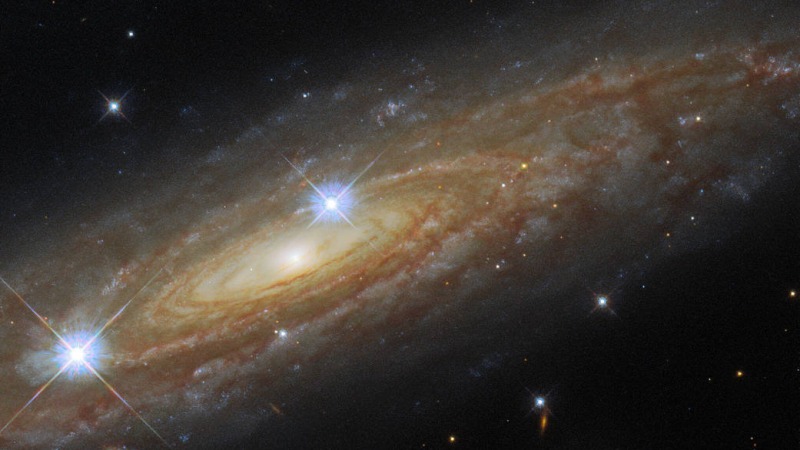Hubble telescope shows the sparkling side of a spiral galaxy
The stunning image was produced during a search for supermassive black holes.

A new Hubble Space Telescope image of a spiral galaxy shows sparkling stars, including a couple that snuck into the foreground.
The telescope captured UGC 11537, a galaxy 230 million light-years away in the constellation Aquila; the galaxy sits at almost 10 times the distance to the spectacular Andromeda Galaxy (M31) that is just barely visible by the naked eye in Earth's sky.
Because UGC 11537 is close to the plane of the Milky Way where most of our galaxy's stars reside, two starry interlopers closer to home snuck into the image, the European Space Agency stated in late November.
Related: The best Hubble Space Telescope images of all time!
"The spikes surrounding these stars are imaging artifacts, called diffraction spikes. They are the result of starlight interacting with the structure that supports Hubble’s secondary mirror," ESA added in its description.
The spiral galaxy's image came during a larger search for supermassive black holes embedded in the heart of these star structures. The study is using Hubble, along with observations from ground-based telescopes, to measure the mass and motions of stars in galaxies like UGC 11537. These metrics will help estimate the mass of the supermassive black holes, ESA said.
Hubble's image came courtesy of data from its Wide Field Camera 3. On Oct. 26, a synchronization error sidelined the camera and other Hubble instruments and put the 31-year-old observatory into safe mode. Engineers adapted the observatory's schedule and carefully put each instrument back online, completing the process on Monday (Dec. 6).
Get the Space.com Newsletter
Breaking space news, the latest updates on rocket launches, skywatching events and more!
A successor telescope to Hubble, called the James Webb Space Telescope, is expected to fly to space on Dec. 22 after years of technical and funding delays. Since Hubble is expected to keep operating well into the 2020s, the two observatories will work together on at least some investigations in the coming years, according to NASA.
Follow Elizabeth Howell on Twitter @howellspace. Follow us on Twitter @Spacedotcom or on Facebook.
Join our Space Forums to keep talking space on the latest missions, night sky and more! And if you have a news tip, correction or comment, let us know at: community@space.com.

Elizabeth Howell (she/her), Ph.D., was a staff writer in the spaceflight channel between 2022 and 2024 specializing in Canadian space news. She was contributing writer for Space.com for 10 years from 2012 to 2024. Elizabeth's reporting includes multiple exclusives with the White House, leading world coverage about a lost-and-found space tomato on the International Space Station, witnessing five human spaceflight launches on two continents, flying parabolic, working inside a spacesuit, and participating in a simulated Mars mission. Her latest book, "Why Am I Taller?" (ECW Press, 2022) is co-written with astronaut Dave Williams.









